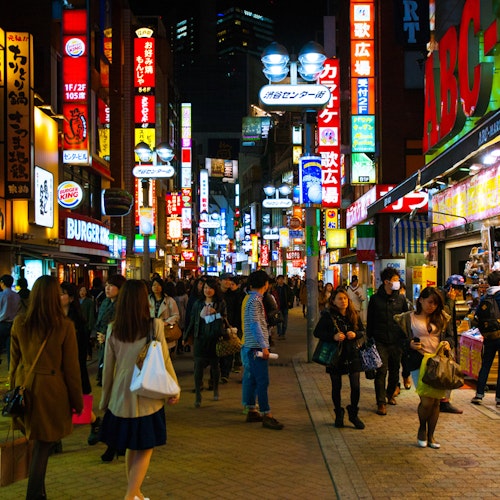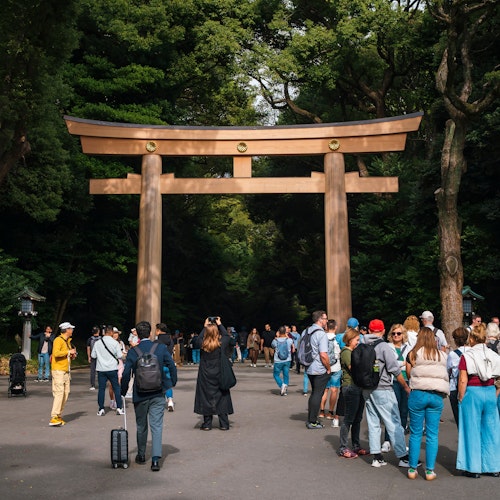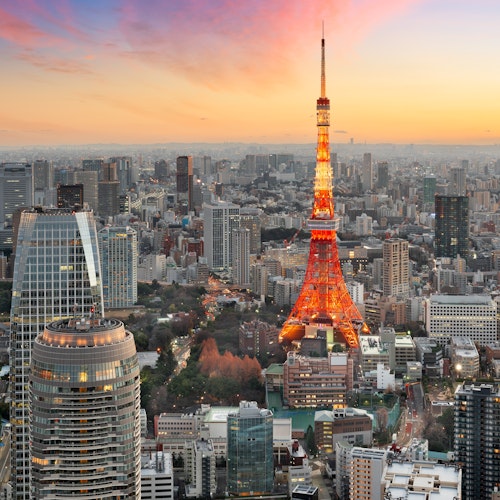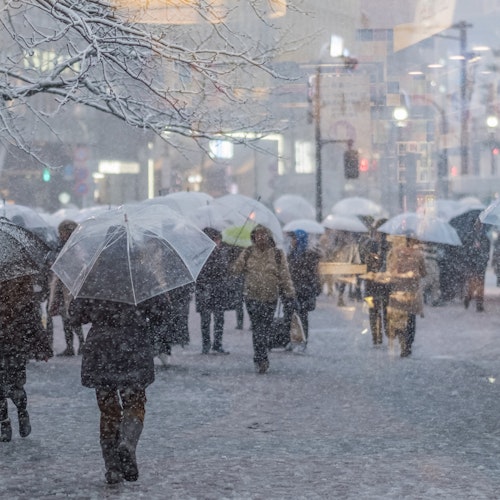
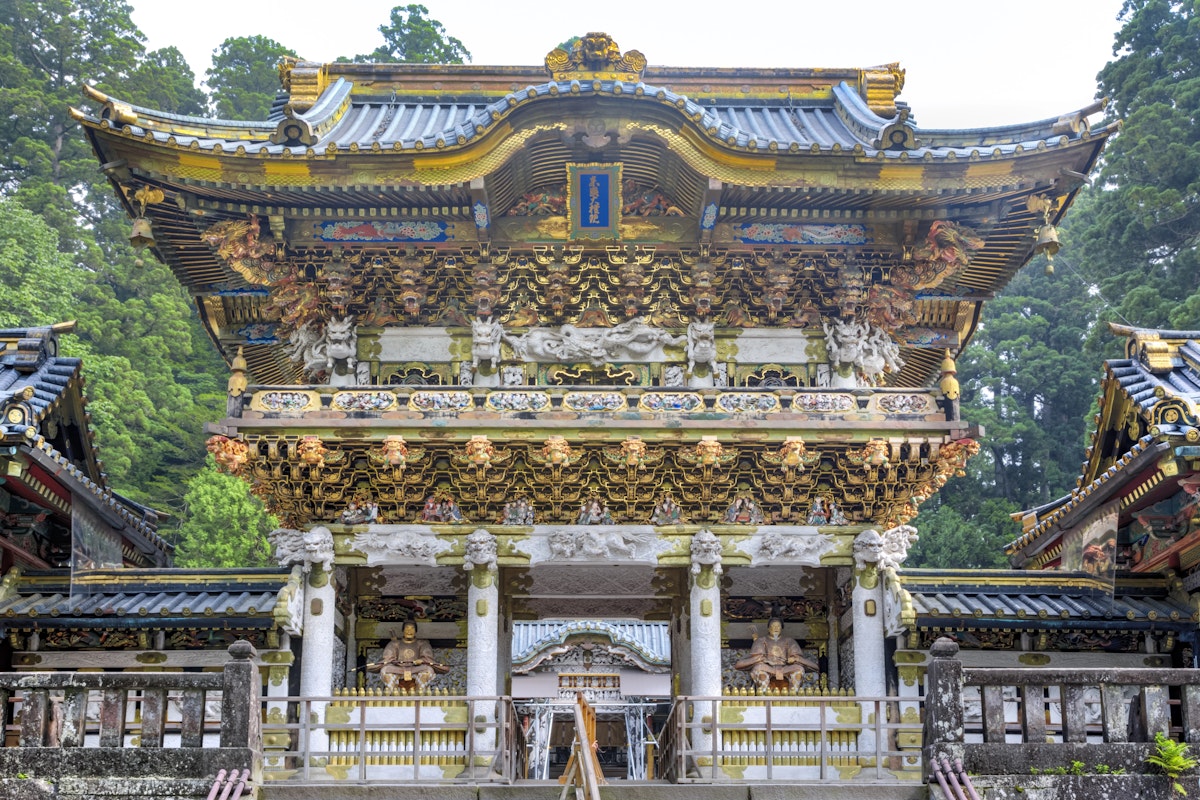
ตั้งอยู่ในเมืองนิกโก้ที่เงียบสงบ ซึ่งเป็นที่รู้จักในด้านความสำคัญทางประวัติศาสตร์และจิตวิญญาณ คุณจะพบกับ ศาลเจ้าโทโชกุ นิกโก้. ศาลเจ้าที่สวยงามนี้ดึงดูดผู้เข้าชมหลายล้านคนในแต่ละปี มันไม่ใช่แค่สถานที่สำหรับสวดมนต์ แต่ยังถูกล้อมรอบด้วยความงามตามธรรมชาติของจังหวัดโทชิกิและเล่าเรื่องราวของประวัติศาสตร์อันยาวนานของญี่ปุ่น
ศาลเจ้าโทโชกุ นิกโก้ มีประวัติศาสตร์ที่ยาวนานซึ่งย้อนกลับไปถึง ยุคเอโดะในญี่ปุ่น มันถูกสร้างขึ้นในปี 1617 เพื่อเป็นที่ระลึกถึงโทคุงาวะ อิเอยาสุ ผู้นำที่เคารพนับถือผู้ซึ่งก่อตั้งโชกุนโทคุงาวะ ซึ่งเป็นยุคที่มีอิทธิพลอย่างมากที่ยาวนานกว่า 250 ปีจนถึงปี 1868.
ศาลเจ้าได้มีการขยายอย่างมากภายใต้การนำของโชกุนโทคุงาวะคนที่สาม ทำให้กลายเป็นคอมเพล็กซ์ที่สวยงามที่ยังคงดึงดูดผู้เข้าชม ศาลเจ้าโทโชกุและโครงสร้างอื่น ๆ ที่อยู่ใกล้เคียงได้รับการยอมรับอย่างสมควรในปี 1999 เมื่อได้รับการประกาศเป็นสถานที่มรดกโลกของยูเนสโก.
การจัดอันดับที่มีเกียรตินี้แสดงให้เห็นถึงความสำคัญทางประวัติศาสตร์และวัฒนธรรมที่ลึกซึ้งของศาลเจ้า ทำให้มันเป็นเพชรนิลจินดาที่มีค่าในภูมิทัศน์วัฒนธรรมของญี่ปุ่น

การผจญภัยเริ่มต้นที่ประตูโทริอิหินที่สวยงามซึ่งเป็นทางเข้าที่มีเกียรติที่ต้อนรับผู้เข้าชมเข้าสู่สถานที่ศักดิ์สิทธิ์นี้ ด้วยความสูงใหญ่และโดดเด่น มันทำหน้าที่เป็นสัญลักษณ์ของสิ่งมหัศจรรย์ที่รออยู่ข้างหน้า.
เมื่อคุณผ่านประตูเข้าไป คุณไม่สามารถช่วยได้ที่จะรู้สึก ประทับใจกับความงามและความคาดหวัง โดยรับรู้ว่ากำลังจะเริ่มต้นการเดินทางที่เต็มไปด้วยอัศจรรย์และความลึกลับ ประตูโทริอินี้เป็นเพียงตัวอย่างหนึ่งในหลายมุมที่อยู่ในพื้นที่ศาลเจ้า แต่ความมีอยู่ที่ยิ่งใหญ่ของมันและการออกแบบที่ประณีตทำให้มันน่าทึ่งอย่างแท้จริง.
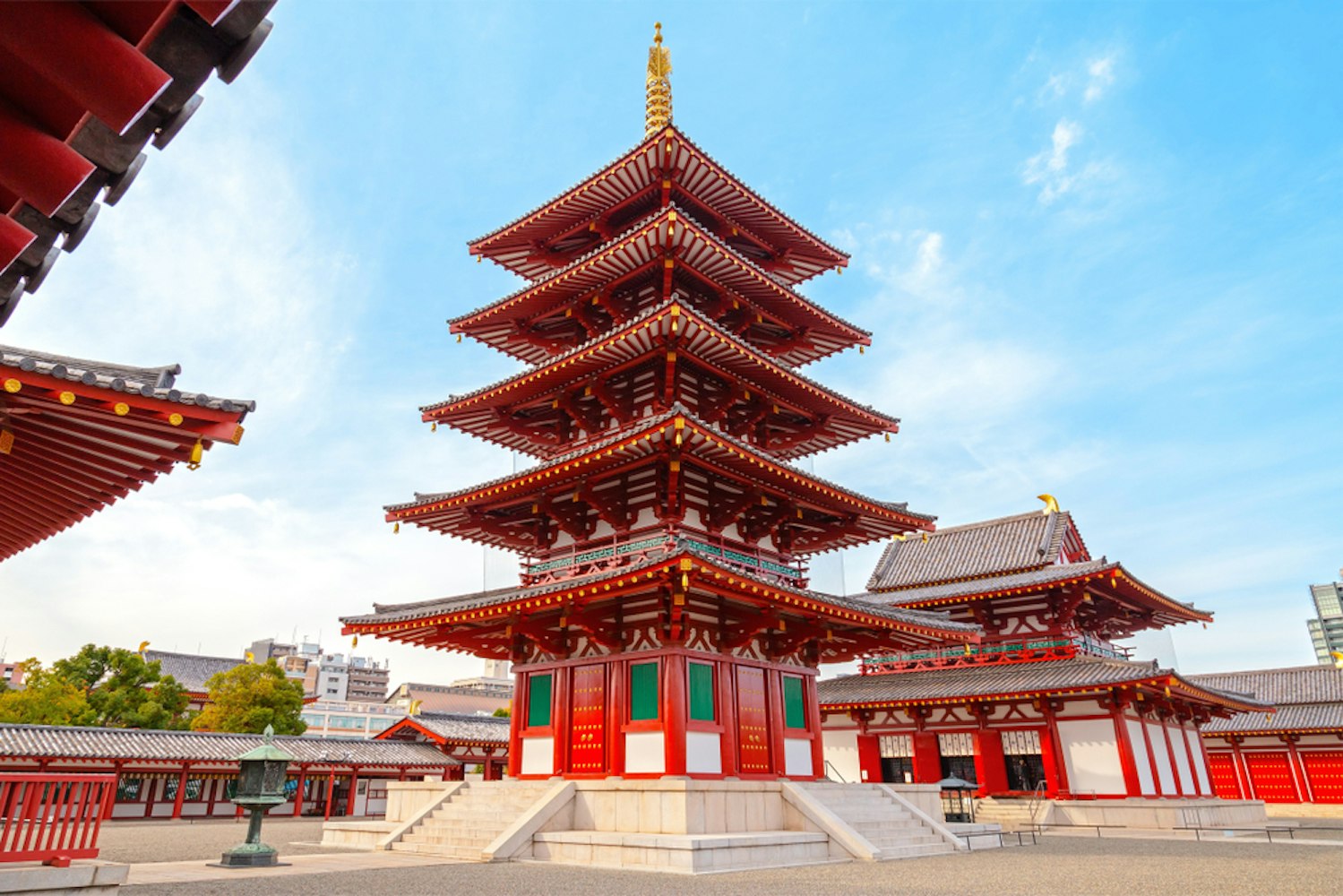
เพียงเลยประตูไปยืนต้นอยู่เจดีย์ห้าชั้นที่งดงามซึ่งเป็นมหัศจรรย์จริงๆของ สถาปัตยกรรมญี่ปุ่น. โครงสร้างที่น่าทึ่งนี้ถูกสร้างขึ้นในปี 1650 ซึ่งเป็นสัญลักษณ์ของมรดกทางวัฒนธรรมและความสำคัญทางจิตวิญญาณตลอดหลายศตวรรษ.
เมื่อคุณเข้าใกล้ คุณไม่สามารถช่วยได้ที่จะหลงใหลในการแกะสลักที่ประณีตซึ่งประดับอยู่ภายนอก เล่าเรื่องราวของตำนานโบราณและธรรมเนียมต่าง ๆ สีสันที่สดใสในแบบของมันแต่ละสีมีความหมายที่ลึกซึ้งสะท้อนถึงความสมดุลและความกลมกลืนใน วัฒนธรรมญี่ปุ่น.
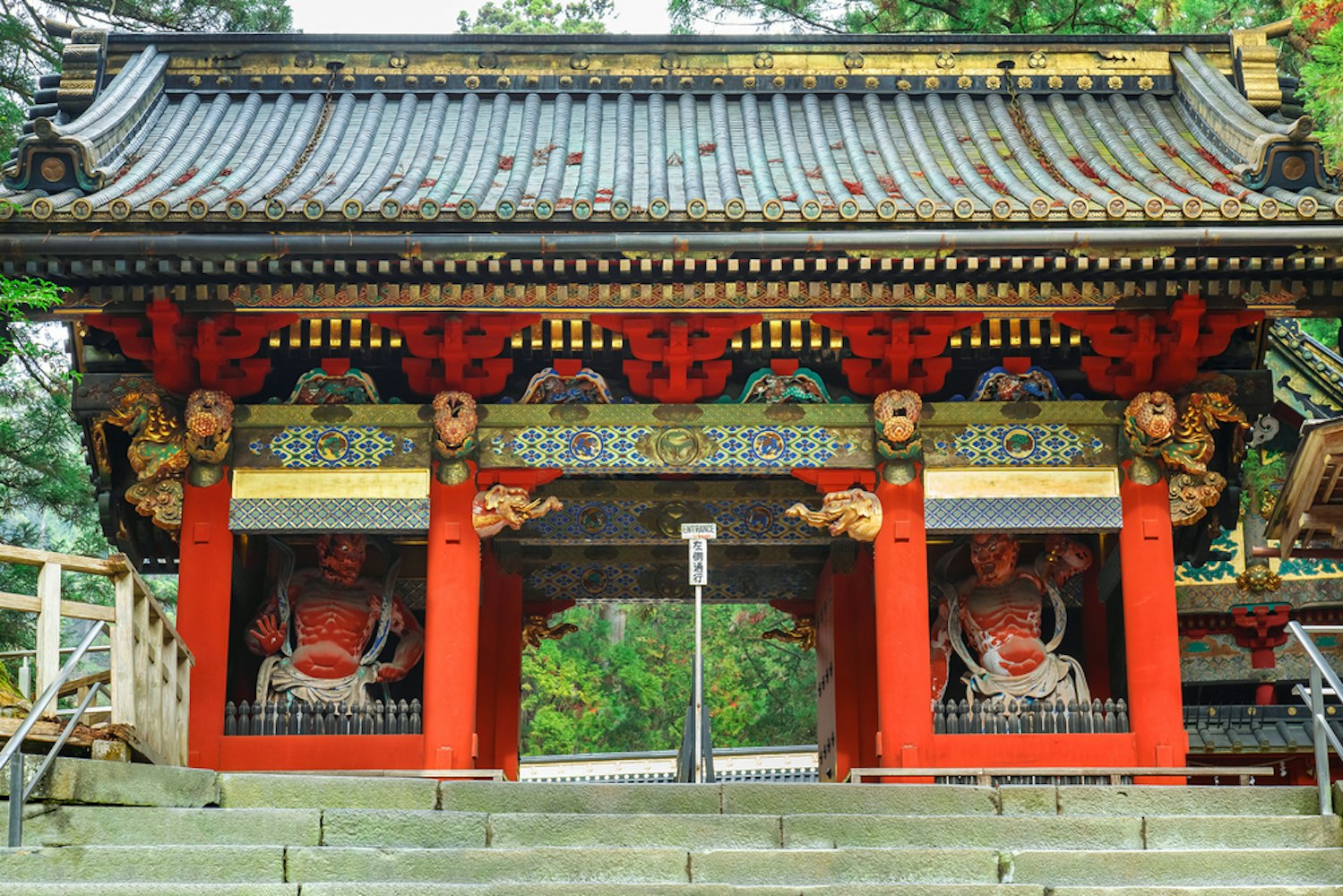
หรือที่เรียกว่าประตูหน้า โอโมเทมอน หรือประตูนีโอ เป็นประตูที่สูงตระหง่านและมีความงดงามซึ่งดึงดูดความสนใจด้วยความเป็นอยู่ที่ยิ่งใหญ่ของมัน ประตูที่มีชื่อเสียงนี้ถูกปกป้องโดยเทพเจ้าสององค์ที่ดูน่ากลัวแต่ก็มีความป้องกันแสดงถึงความสำคัญทางวัฒนธรรมและความยิ่งใหญ่ทางประวัติศาสตร์.
ประดับด้วยการแกะสลักไม้ที่ซับซ้อน รวมถึง "มังกรร้องไห้" ที่มีชื่อเสียง ประตูนี้เป็นผลงานชิ้นเอกที่แสดงถึงความสามารถและพรสวรรค์ของผู้สร้าง มันมีรายละเอียดและการออกแบบที่ประณีตบอกเล่าเรื่องราวเกี่ยวกับมรดกและธรรมเนียมที่ได้สร้างตัวตนของมันทำให้มันกลายเป็น สมบัติของชาติที่ยังคงดึงดูดและสร้างแรงบันดาลใจให้กับผู้เข้าชมทั่วโลก.
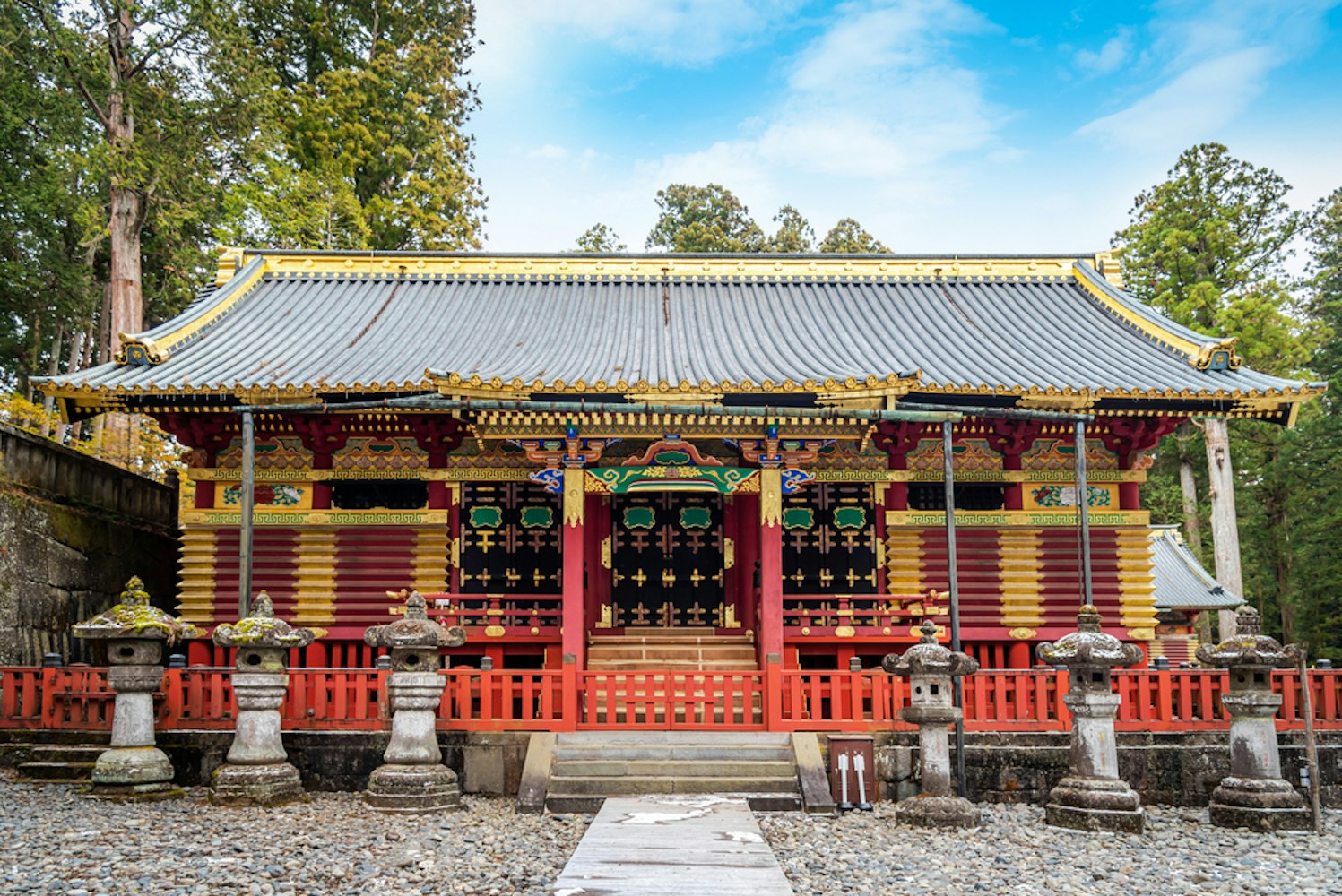
โกดังเหล่านี้ประดับด้วยการตกแต่งที่สวยงาม แสดงให้เห็นถึงความสำคัญในการใช้งานของศาลเจ้า พวกมันเก็บสิ่งของในพิธีและ ศาลเจ้า ขนาดเล็กที่มีชีวิตชีวาในระหว่างเทศกาลฤดูใบไม้ผลิและฤดูใบไม้ร่วงที่ยิ่งใหญ่ของโทโชกุ.
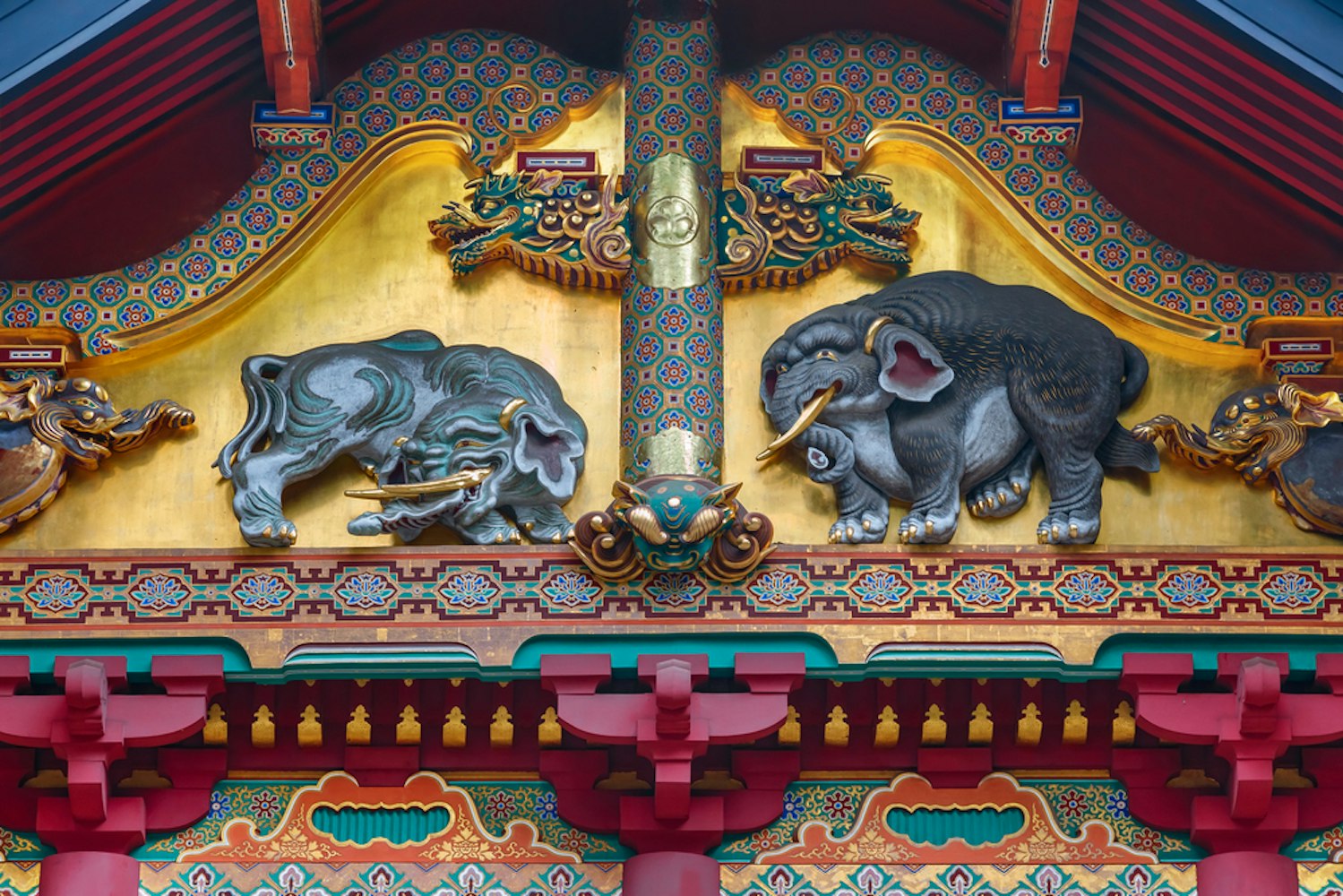
อาจจะเป็นหนึ่งในลักษณะที่น่ารักที่สุดของศาลเจ้าคือ "ช้างที่จินตนาการ" การแกะสลักที่มีความคิดสร้างสรรค์ที่สร้างขึ้นโดยศิลปินที่มีพรสวรรค์ซึ่งไม่เคยเห็นช้างจริงมาก่อน ด้วยความอยากรู้อยากเห็นแบบเด็กและจินตนาการที่สดใส ศิลปินได้นำพาสิ่งมีชีวิตเวทมนตร์เหล่านี้มามีชีวิต ตกแต่งด้วยรายละเอียดที่ซับซ้อนเช่น งวงที่โค้งอย่างมีเอกลักษณ์ หูที่ประดับลวดลาย และเขี้ยวที่แกะสลักอย่างประณีต.
ช้างที่จินตนาการแต่ละตัวมีบุคลิกภาพที่เป็นเอกลักษณ์ ดึงดูดใจผู้เข้าชมด้วยเรื่องตลกและเสน่ห์ที่ยากจะต้านทาน เหล่าสิ่งมีชีวิตมหัศจรรย์เหล่านี้ได้กลายเป็นสถานที่ท่องเที่ยวที่ชื่นชอบมานานหลายศตวรรษ ดึงดูดจินตนาการของทุกคนที่พบเห็น.

ที่อยู่อาศัยของม้าศักดิ์สิทธิ์ของศาลเจ้า มีการแกะสลักชื่อดังที่เรียกว่า "ลิงสามตัว" ซึ่งแสดงถึงหลักการที่คลาสสิกไม่มีเวลาอย่าง "ไม่เห็นชั่วร้าย ไม่ได้ยินชั่วร้าย ไม่พูดชั่วร้าย" งานศิลปะที่ดึงดูดนี้ที่ถูกสร้างด้วยความแม่นยำอันยอดเยี่ยม เป็นการเตือนที่ทรงพลังในการหลีกเลี่ยงอิทธิพลเชิงลบและปฏิบัติพฤติกรรมที่มีคุณธรรมในทุกด้านของชีวิต.
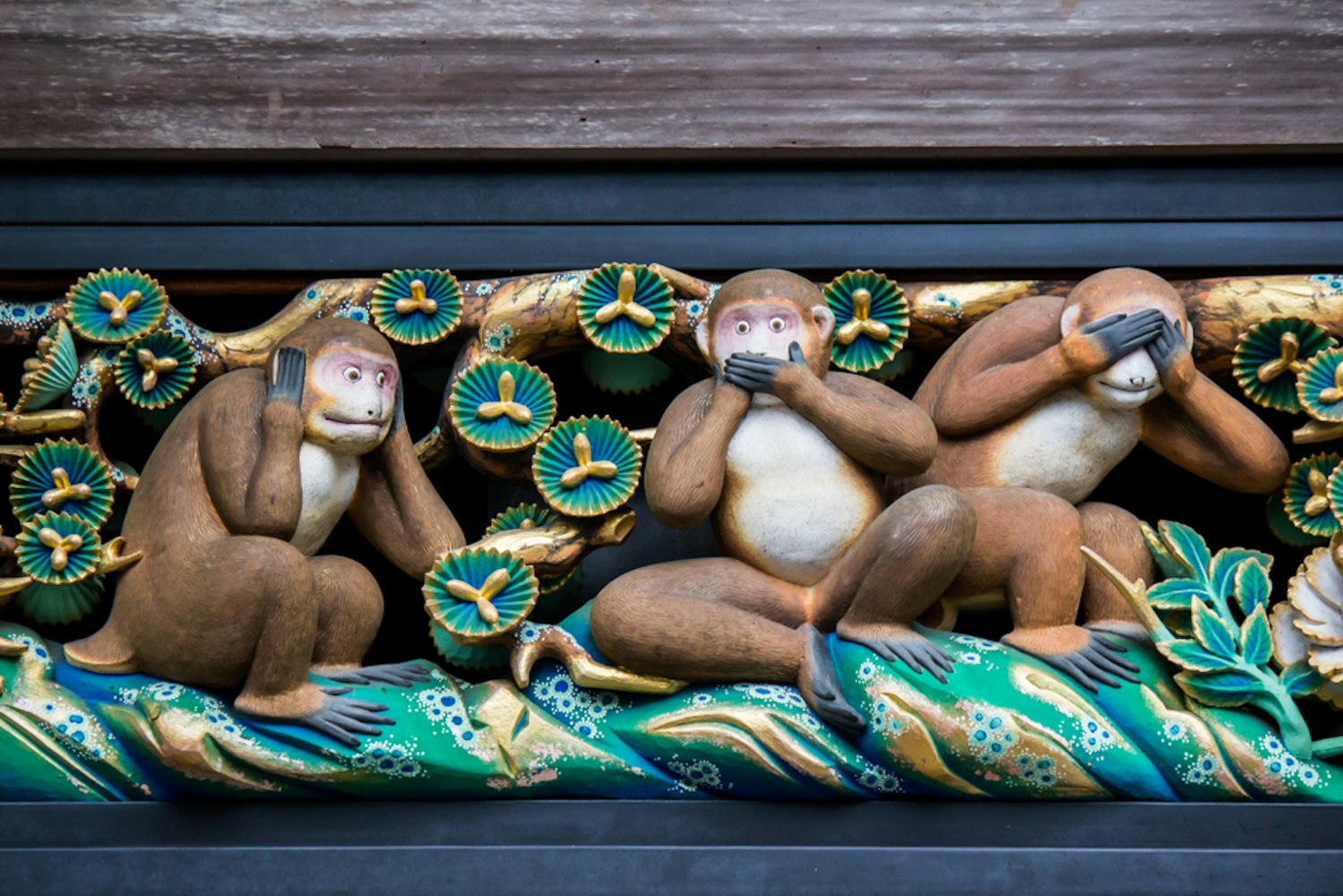
การแกะสลักของลิงสามตัวที่คอกม้าศักดิ์สิทธิ์เป็นตัวแทนที่ได้รับการยกย่องและเคารพตลอดกาลเกี่ยวกับบทเรียนที่เด่นชัดของชีวิต แสดงถึงการดำรงอยู่ของมนุษย์ การแกะสลักที่สร้างขึ้นอย่างประณีตนี้จับ essence ของสติปัญญา ความบริสุทธิ์ และประสบการณ์.
เมื่อผู้เข้าชมมองไปที่งานศิลปะที่ซับซ้อนเหล่านี้ พวกเขาจะถูกพาไปสู่โลกที่ความซับซ้อนของชีวิตผสมผสานอยู่กับความเรียบง่ายของความจริงที่เป็นสากล.
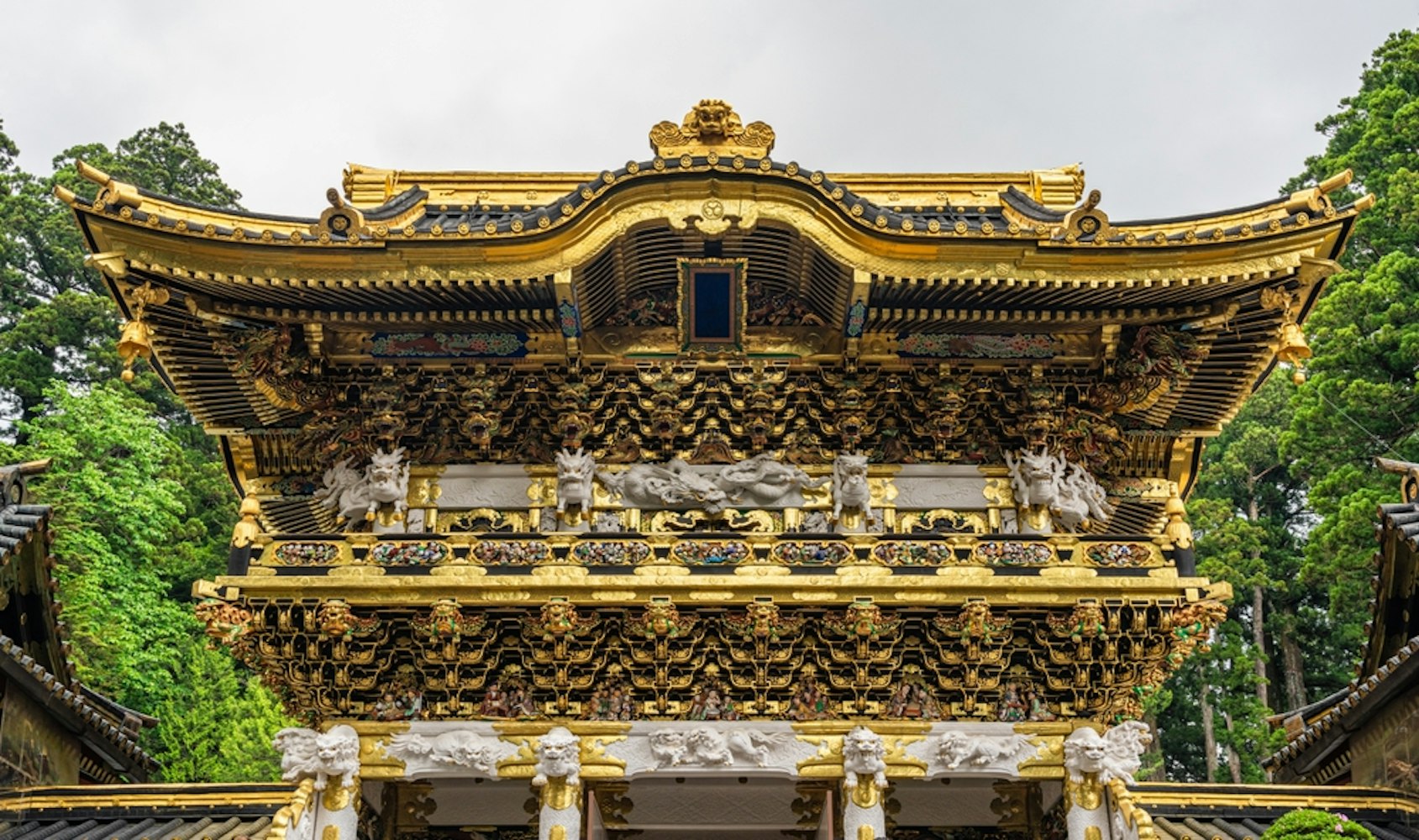
ประตูโยมิโมน, ตั้งอยู่ในนิกโก้ ประเทศญี่ปุ่น เป็นผลงานสถาปัตยกรรมที่น่าทึ่งที่ทำให้ผู้เข้าชมประหลาดใจเสมอ โครงสร้างที่งดงามนี้ประดับประดาด้วยการแกะสลักที่ซับซ้อนและประดับด้วยทองคำ ซึ่งแสดงถึงความสามารถที่ไม่มีใครเหมือนของยุคเอโดะ.
ประตูโยมิโมนซึ่งมักถูกยกย่องว่าเป็น "ประตูแห่งแสงแดด" มอบความงามที่ส่องแสงและน่าประทับใจทำให้มีความทรงจำที่ยาวนานในทุกคนที่ได้เห็น.
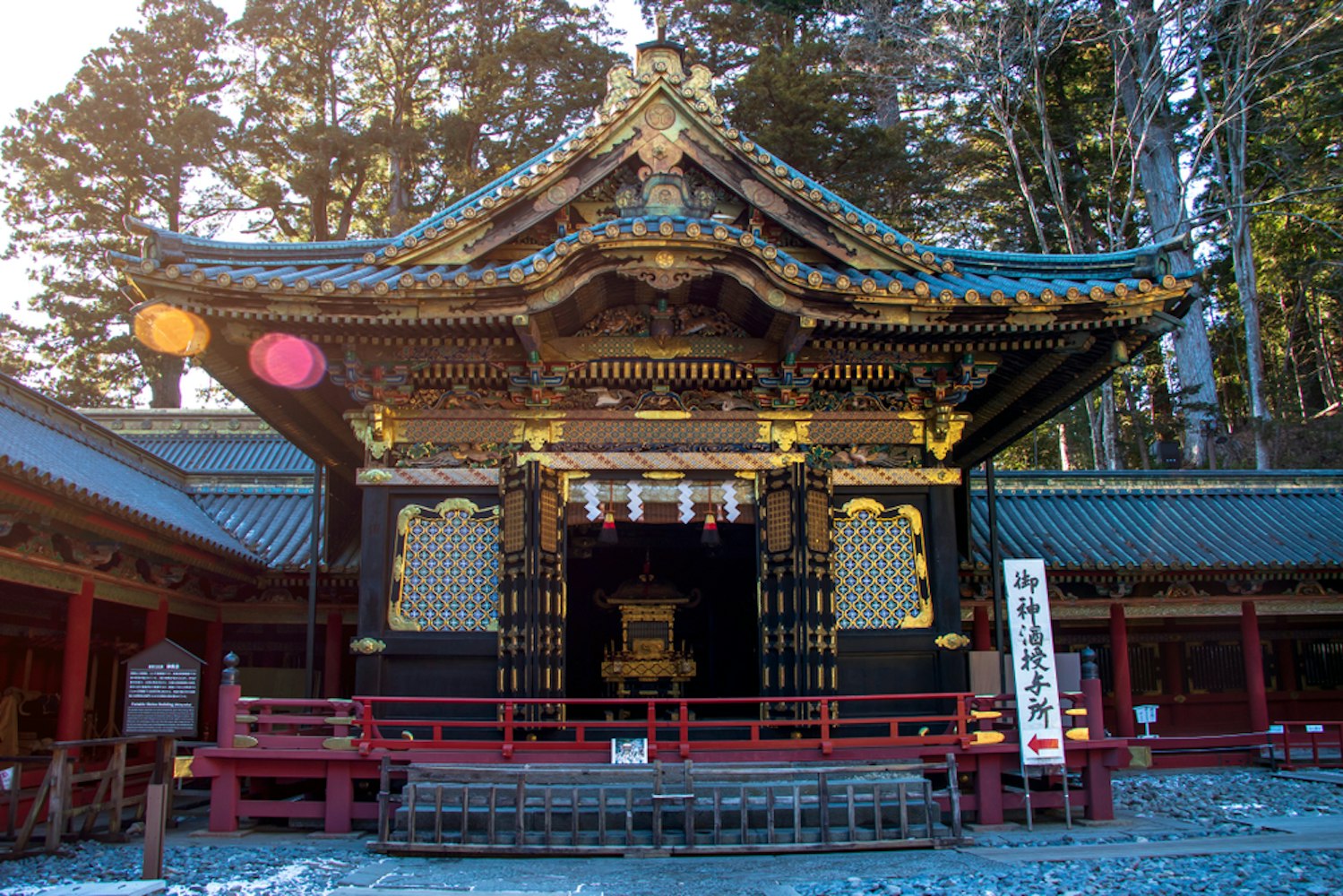
ในนิทรรศการที่งดงามนี้ มีศาลเจ้าขนาดเล็กสามแห่งที่สร้างขึ้นอย่างประณีตจากไม้ที่ดีที่สุดประดับด้วยการเคลือบสีที่ซับซ้อนและทองคำอ่อนอย่างละเอียด ผลงานชิ้นเอกเหล่านี้เป็นการแสดงออกซึ่งความหรูหรา สุนทรียภาพ และความยิ่งใหญ่ของยุคนี้ เป็นหลักฐานถึงมรดกทางวัฒนธรรมที่ลึกซึ้งและการสร้างสรรค์ในยุคนั้น.
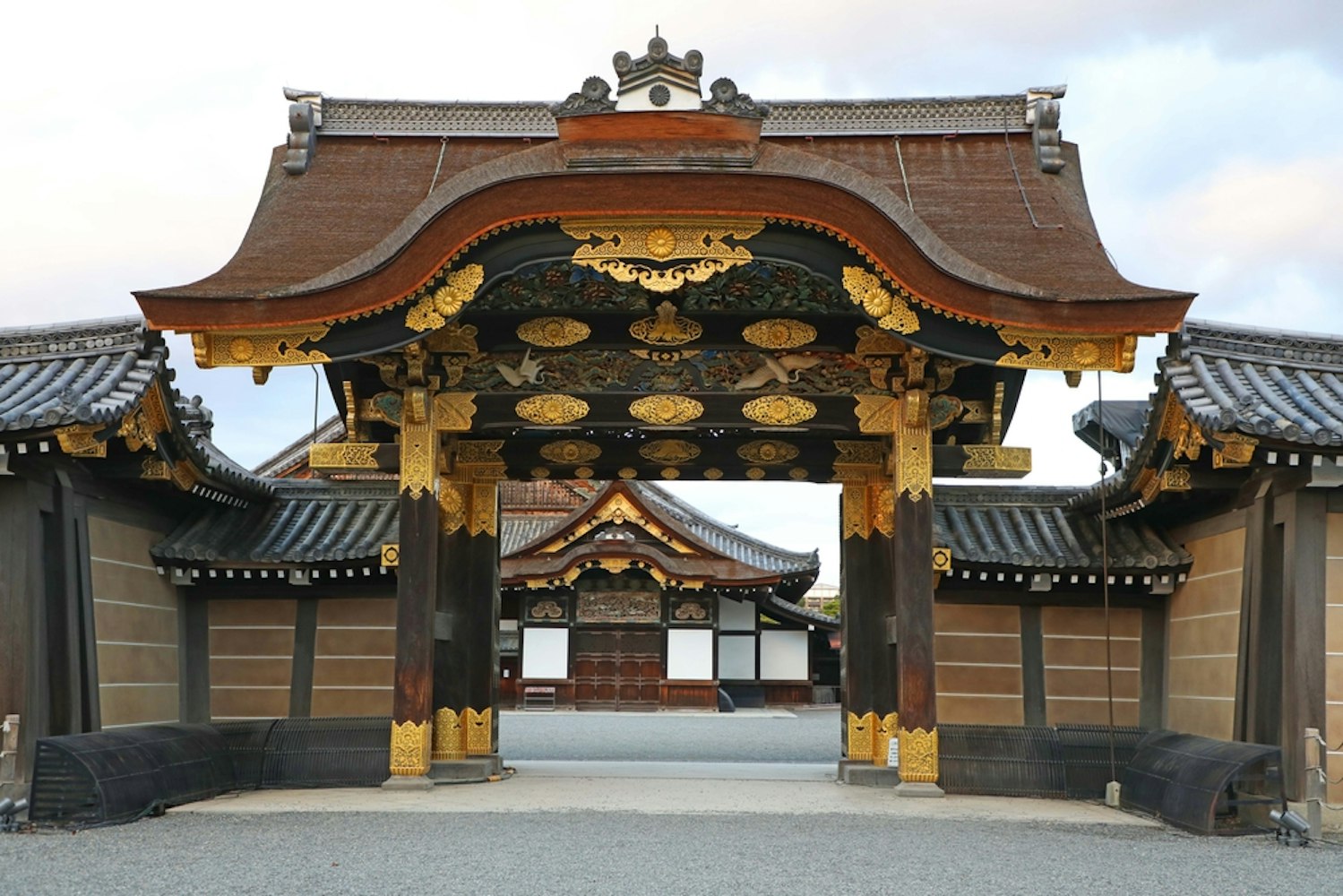
คาระมอน, ประตูในแบบจีน ยินดีต้อนรับผู้เข้าชมเข้าสู่ศาลเจ้าหลัก ด้วยความสูงและงดงาม โครงสร้างที่สวยงามนี้ประดับด้วยการแกะสลักที่ซับซ้อน แสดงถึงนกที่สวยงาม ดอกไม้ที่ละเอียดอ่อน และสิงโตจีนแบบดั้งเดิม.
ผลงานทางสถาปัตยกรรมที่น่าทึ่งนี้จับความงามและฝีมือของทุก ๆ รายละเอียดอย่างประณีต.
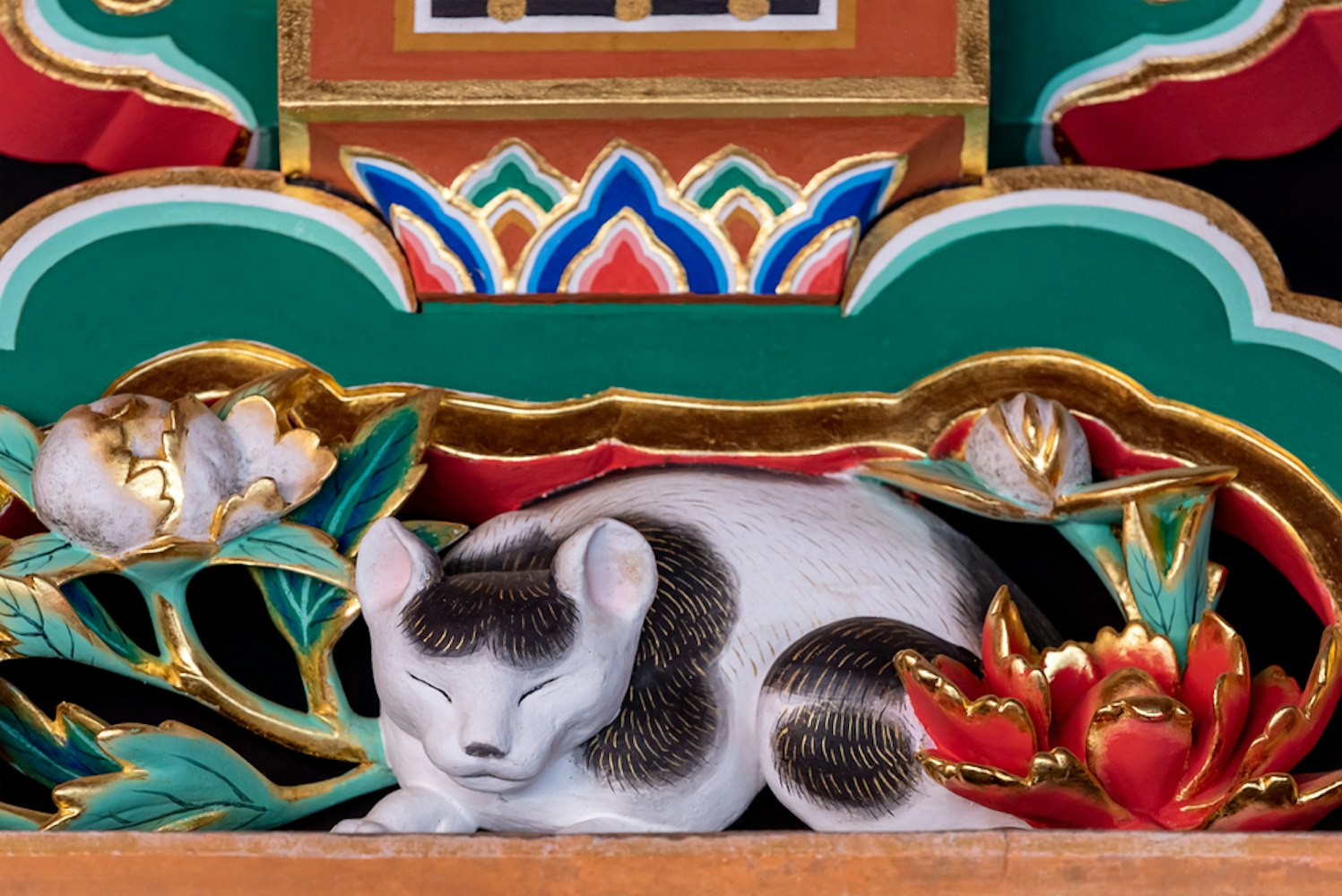
หนึ่งในการแกะสลักที่มีชื่อเสียงที่สุดในประวัติศาสตร์ศิลปะญี่ปุ่น เนมูริเนโกะ, หรือแมวหลับ ซึ่งถูกแกะสลักอย่างประณีตโดยศิลปินที่มีชื่อเสียง ฮิดาริ จิงโงะ นี่คือผลงานชิ้นเอกที่ละเอียดอ่อนซึ่งแกะสลักจากไม้ชิ้นเดียวกันที่เชื่อกันว่ามีความหมายถึงสันติภาพและความกลมกลืนสงบในเขตศักดิ์สิทธิ์ของศาลเจ้า.
ตามตำนาน เนมูริเนโกะมีความสงบเงียบมากจนไม่มีหนูตัวไหนกล้าที่จะรบกวนการนอนหลับอันแสนสุขของมัน ยิ่งเสริมให้เกิดความสงบที่ฟุ้งอยู่ในบริเวณศาลเจ้า.
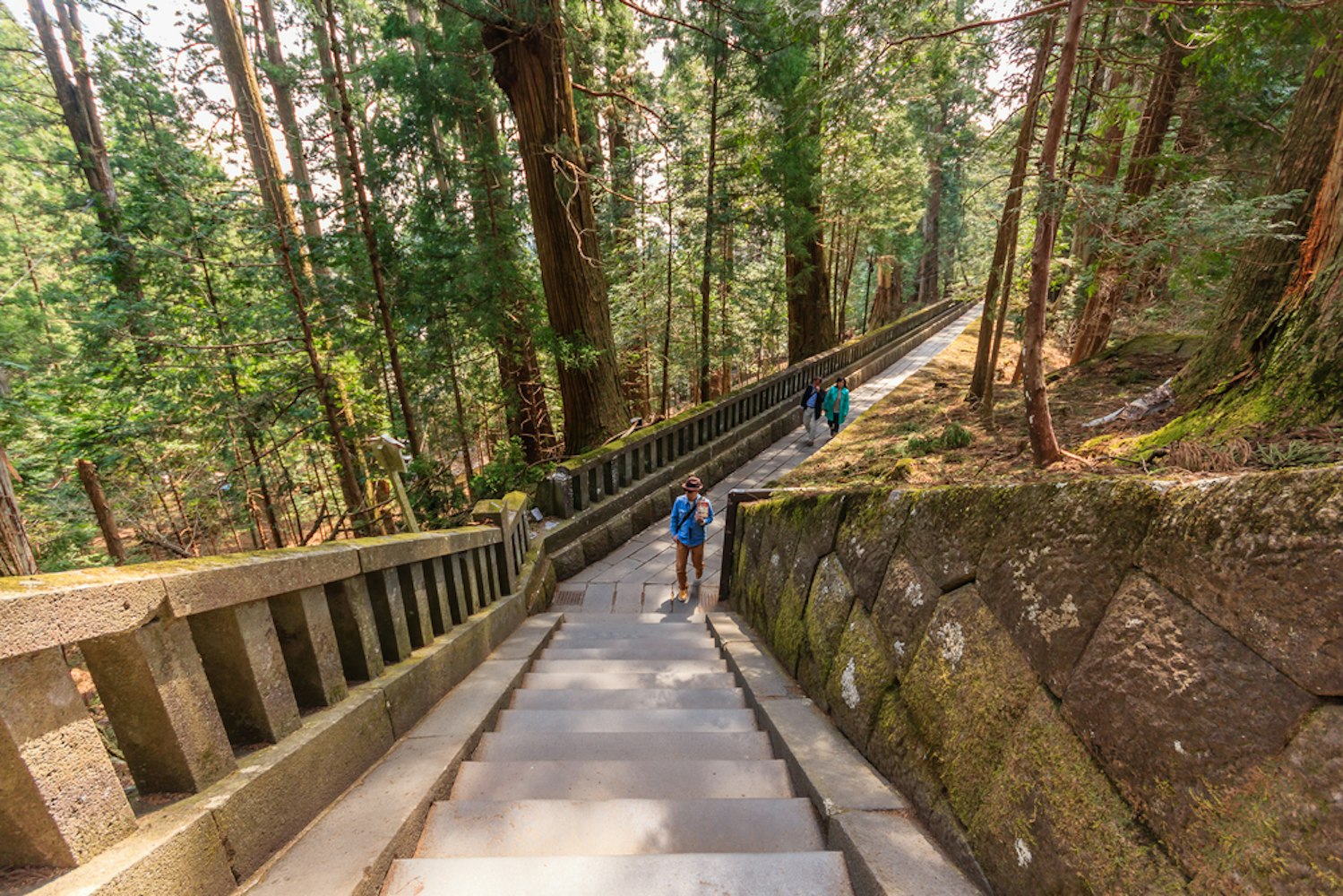
การขึ้นบันไดโบราณเหล่านี้นำพาผู้แสวงบุญเข้าสู่การเดินทางศักดิ์สิทธิ์สู่ศาลเจ้าภายในที่เคารพซึ่งโทคุงาวะ อิเอยาสุ ได้พักผ่อนนิรันดร์ เมื่อคุณไต่ขึ้นไป ความรู้สึกสงบจะซึมซาบ ทำให้เกิดความแตกต่างที่ชัดเจนจากความหรูหราที่รออยู่ในเขตด้านล่าง.
อากาศเต็มไปด้วยความเคารพและเสียงกระซิบของประวัติศาสตร์ ทำให้การเดินทางแสวงบุญนี้เป็นประสบการณ์ที่เปลี่ยนแปลงอย่างแท้จริง.

สุสานของโทคุงาวะ อิเอยาสุ ผู้ก่อตั้งโชกุนโทคุงาวะ เป็นโครงสร้างที่เรียบง่าย มีการออกแบบที่เรียบง่ายและถ่อมตน สไตล์สถาปัตยกรรมของมันแตกต่างอย่างเด่นชัดกับความหรูหราและความยิ่งใหญ่ของอาคารที่อยู่รอบๆ เน้นถึงความเคารพและความสงบ.
บรรยากาศที่สงบของสุสานเชิญชวนให้ผู้เข้าชมหยุดพักและคิด ให้เวลาสำหรับการตอบสนองและการพิจารณาในบริเวณสำคัญทางประวัติศาสตร์นี้.
คุณจะพบกับศาลเจ้าแห่งแรงบันดาลใจนี้ห่างออกไปเพียงไม่กี่ชั่วโมงจากมหานครหลวงโตเกียว ตั้งอยู่ในอุทยานแห่งชาติ นิกโก้ที่เงียบสงบและเขียวขจี สถานที่ที่งดงามนี้มีชื่อเสียงในด้านภูมิทัศน์ที่สวยงามและมีวิวทิวทัศน์ที่ตระการตาซึ่งมีต้นไม้เขียวชอุ่มและภูเขาที่งดงามสร้างแบ็คกราวด์ที่น่าทึ่ง.
นิกโก้มีบริการขนส่งสาธารณะอย่างดี และการไปยังสถานที่มรดกโลกของมันนั้นง่าย.
จากสถานี นิกโก้ หรือสถานี โทะบุนิกโก้ รถบัสทัวร์สถานที่มรดกโลกจะจอดที่สถานที่ของยูเนสโกในนิกโก้รวมถึงศาลเจ้าโทโชกุนิกโก้ การเดินทางใช้เวลาประมาณ 15 นาที.
หากมีเวลา การเดินจากสถานีนิกโก้ใช้เวลาประมาณ 45 นาทีและอนุญาตให้เข้าสู่พื้นที่มรดกโลกจากสะพานชินเคียว ประตูทางเข้าสถานที่ศักดิ์สิทธิ์ในนิกโก้.
เวลาเปิดทำการ
ศาลเจ้าจะเปิดเวลา 8:00 น. และปิดเวลา 17:00 น. (เข้าได้ถึง 16:30 น.) ตั้งแต่เดือนเมษายนถึงเดือนตุลาคม และจนถึง 16:00 น. (เข้าได้ถึง 15:30 น.) ตั้งแต่เดือนพฤศจิกายนถึงเดือนมีนาคม.
ค่าธรรมเนียมเข้าชม
การเข้าใช้ศาลเจ้าโทโชกุ นิกโก้ มีค่าธรรมเนียม 1,300 เยนสำหรับผู้ใหญ่และ 450 เยนสำหรับเด็ก สำหรับผู้ที่ต้องการศึกษาเพิ่มเติมเกี่ยวกับประวัติศาสตร์ พิพิธภัณฑ์โทโชกุ นิกโก้มีสิ่งของและคำอธิบายที่หลากหลาย โดยมีค่าธรรมเนียมการเข้าชมแยกต่างหากที่ 800 เยนสำหรับผู้ใหญ่และ 400 เยนสำหรับเด็ก.
เพื่อความสะดวกของผู้เข้าชม มีแผนที่และป้ายบอกสถานที่หลายแห่งโดยรอบสถานีโทะบุ นิกโก้ รถบัสท่องเที่ยวมรดกโลกยังมีไว้ซึ่งเชื่อมโยงศาลเจ้ากับสถานที่ท่องเที่ยวที่สำคัญอีกแห่งหนึ่งในนิกโก้.
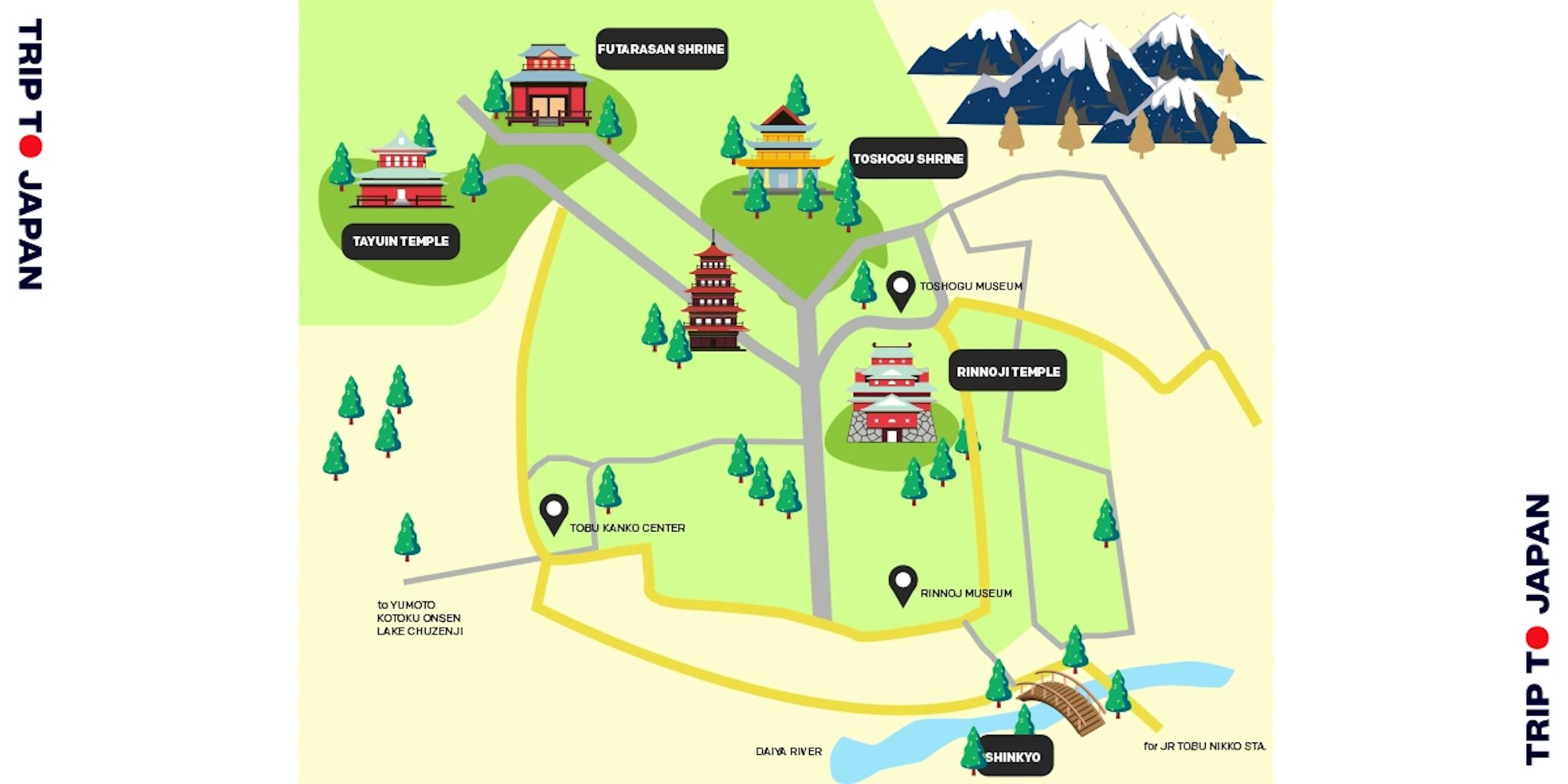
การใช้เวลาสักครู่ในการวางแผนเส้นทางของคุณจะทำให้การเดินทางผ่านผลงานทางประวัติศาสตร์นี้เป็นไปอย่างราบรื่น.
ศาลเจ้านิโก้โทโชกุ มากกว่าความมหัศจรรย์ทางสถาปัตยกรรม; มันเป็นการเดินทางผ่านประวัติศาสตร์อันยาวนานของญี่ปุ่น เป็นข้อพิสูจน์ถึงฝีมือช่าง และเป็นที่พักผ่อนที่เงียบสงบในธรรมชาติ ไม่ว่าคุณจะเป็นแฟนประวัติศาสตร์ ผู้หลงใหลในสถาปัตยกรรม หรือบุคคลที่แสวงหาประสบการณ์ในวัฒนธรรมญี่ปุ่น โทโชกุเสนอประสบการณ์ที่ไม่เหมือนใครและไม่สามารถลืมได้.
เมื่อคุณยืนอยู่ท่ามกลางโครงสร้างที่ประดับประดาอย่างฟุ่มเฟือย คุณจะถูกเตือนถึงความมุ่งมั่นและความหลงใหลของผู้ที่สร้างมันขึ้นและยังคงดูแลรักษามัน.
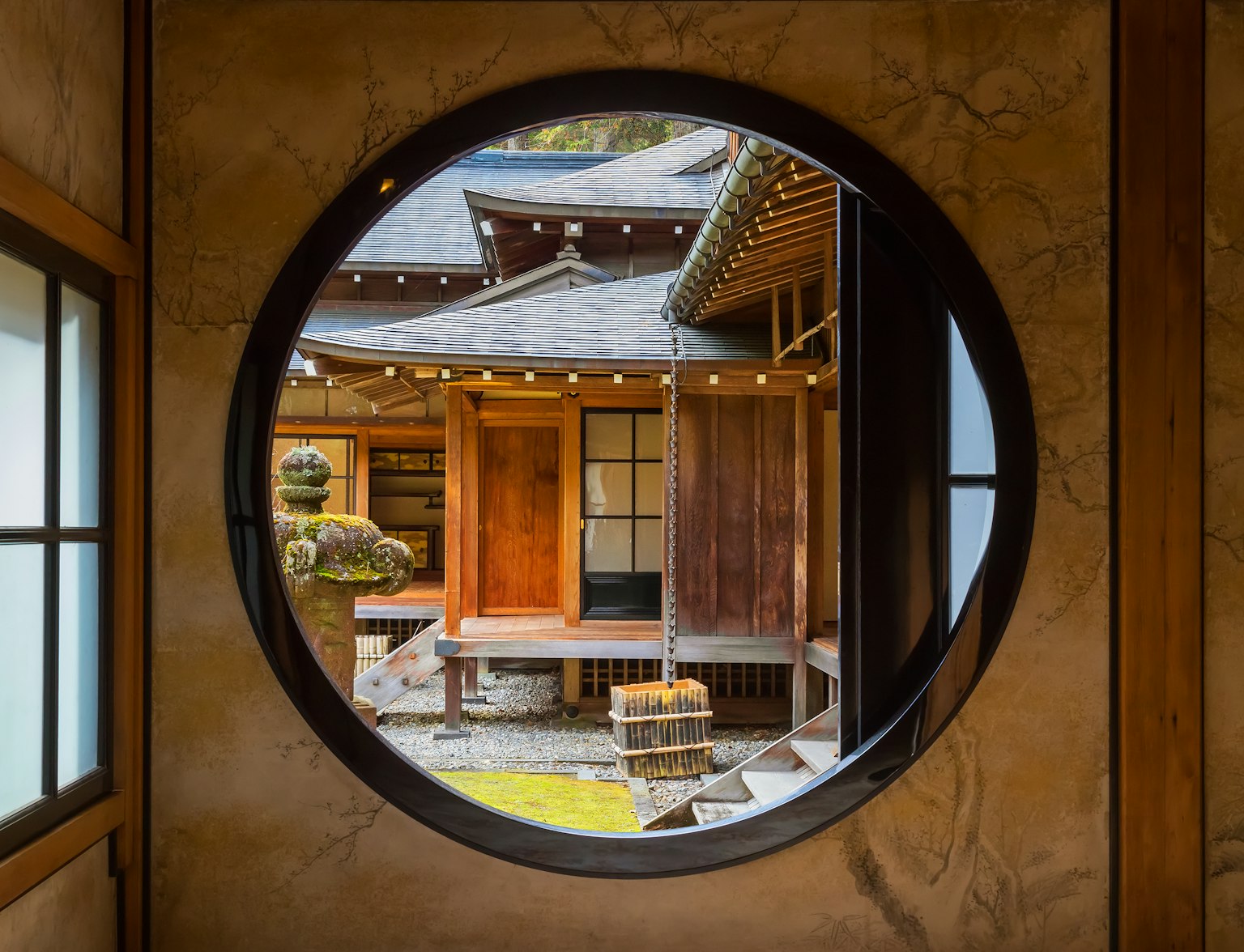
เยี่ยมชมสถานที่มรดกโลกของยูเนสโกในนิกโก้กับทัวร์นี้
